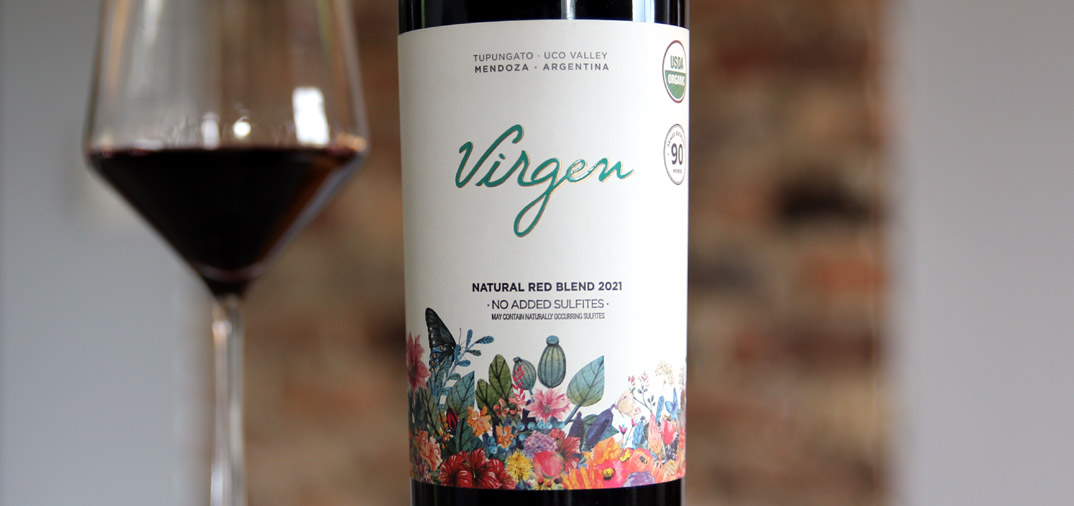 4.5
4.5 Review: Virgen, Organic Red Blend
It’s interesting to think about the idea of organic products when you look at it through the history of time. 100 years ago, most things that you could buy in a supermarket would be considered organic, by current standards, but they weren’t marketed that way because it wasn’t something people thought about at the time.
What is currently referred to as “conventional agriculture” (i.e., relying on the use of chemical inputs and genetically modified seeds) didn’t even exist back then. Today’s “conventional agriculture” was largely born after World War II, and much of the original science behind it was developed as a part of the war effort. If it’s not even 100 years old, how is it considered conventional?
Most consumers, including myself, have only a basic understanding of farming practices. I would venture to guess that most consumers who are aware of organic farming think of it in binary terms — either you use chemical inputs or you don’t. But it’s not that simple.
In organic farming, there are often some chemical inputs, but those inputs are considered less toxic and are approved for organic production. There are also additional practices that can be applied but aren’t necessarily required for products to be considered organic. Some examples are conservation agriculture, which incorporates crop rotation and minimal soil disturbance, or regenerative agriculture, which focuses heavily on soil health by keeping live roots in the grounds all year and adding biodiversity, including grazing animals.
It fascinates me that in less than 100 years, humans reinvented agriculture and now it’s almost considered revolutionary to go back to the old ways of doing things. And again, most people don’t have a deep understanding of it.
Organic Wine
Over the past 15 years that I’ve been writing about wine, I’ve noticed more and more wine brands embracing organic production practices. It used to be difficult to find wine made from organically grown grapes, but it’s more and more common today.
Even though it’s become easier to find wine made from organically grown grapes, it’s still less common to find wine labeled as “organic wine.” That’s because USDA organic labeling guidelines require that “organic wine” is not only made from organically grown grapes, but is also produced without the addition of sulfites in the winemaking process.
All wine, even organic wine, has some sulfites in it. But most winemakers add additional sulfites in order to give the wine a longer shelf life and to protect it from spoilage. It takes extreme care to create a shelf stable wine without the addition of sulfites. This is yet another thing a lot of consumers likely don’t fully understand.
Domaine Bousquet Virgen Wines
Starting a few years ago, Domaine Bousquet took on the challenge of creating USDA certified organic wines, sold under their Virgen brand.
Organic farming practices were employed at Domaine Bousquet from the time their vineyards were first established in 1997. Their vineyards are located in a high desert region in Alto Gualtallary, a subregion of Tupungato in Mendoza, Argentina. The dry conditions and sandy soils here lend themselves well to organic farming.
Recently, Domaine Bousquet’s vineyards also become Regenerative Organic Certified (ROC), which goes above and beyond basic organic standards.
Beginning with the 2018 vintage, Domaine Bousquet set out to produce wines that were fully organic, in the winery as well as the vineyard. In order to do so, they had to be extra vigilant with keeping the winery clean. Fermentation was also done at lower temperatures and monitored closely. The wine was then wrapped in thermal blankets to protect it during shipment to the US.
You might think that this would result in a more expensive wine, but you would be mistaken. They did all this and still sell these wines for a suggested retail price of only $13 per bottle. That’s amazing.
They produce a Red Blend, Chardonnay, Cabernet Sauvignon and Malbec under the Virgen label. The wine I’m tasting today is the Virgen Red Blend, which is made from 35% Malbec, 35% Cabernet Sauvignon and 30% Cabernet Franc.
Tasting Notes
The nose on this wine is beautiful, offering a nice balance of fruit and spice, with aromas such as blackberry, blueberry, allspice, culinary herbs and a soft floral note. On the palate the silky smooth mouthfeel is the first thing that gets your attention. The flavors are delicious too, with concentrated blackberry, blueberry, black cherry and a touch of spice. The acidity is nice and vibrant. It finishes with lingering berry flavors and a light touch of tannins.
Wine: Domaine Bousquet, Virgen Organic Red Blend
Varieties: 35% Malbec, 35% Cabernet Sauvignon, 30% Cabernet Franc
Vintage: 2021
Alcohol: 14%
Rating: 90
Average price: $13
Disclosure: This wine was received as a media sample.











Comment(2)